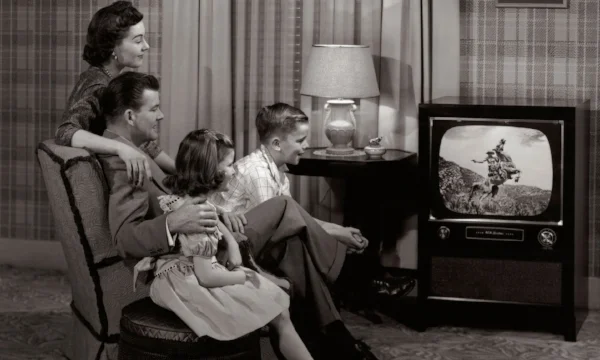Mac Attacked
National Review Online, July 7, 2003
Chicago, October 1989 © Andrew Stuttaford
The realization came as I chowed down on a good breakfast of egg, sliced Canadian style bacon (water added!), sweeteners (one or more of sugar, dextrose or corn syrup solids), the salts of the earth and laboratory (specifically sodiums phosphate, pyrophosphate, aluminum phosphate, erythorbate, nitrite, citrate, stearoyl-2-lactylate and good old salt), enriched (a cocktail of thiamine, riboflavin, niacin, iron and folic acid), bleached wheat flour (confusingly, wheat flour may contain malted barley flour), vital wheat gluten, trivial wheat gluten, yeast, (and, self-sufficiently, yeast nutrients — ammonium sulfate, calcium sulfate, calcium carbonate, ammonium chloride, non-calcium phosphate), partially hydrogenated (more water!) soybean oil (except when it's cottonseed), vinegar, high fructose corn syrup, corn meal, soy flour, soy lecithin, lecithin without soy, dough conditioners (an intriguing blend of calcium peroxide, mono-and diglycerides), numerous acids (fumaric, acetic, citric, sorbic and ascorbic), calcium propionate, potassium sorbate, corn starch, beta carotene, eye of newt (all right, I made that one up), cultured milk, cheese culture, unsophisticated cream, enzymes, sinister-sounding "fungal" enzymes and, a touch weirdly under the circumstances, colors and flavors just known as "artificial," all washed down with carbonated water, caramel color, more acid (phosphoric and citric this time), more sodium (saccharin — "cause[s] cancer in laboratory animals!"), "natural" flavors (and, helping nature out, potassium benzoate "to protect taste"), caffeine, potassium citrate, aspartame, and, finally, that proofreader's nightmare, dimethylpolysiloxane. McDonald's really, really wanted me to know the contents of an Egg McMuffin and a Diet Coke and, yes, there is, indeed, such a thing as too much information.
I was in a Mickey D's on a main street somewhere in northern Massachusetts. It was a bleak, blue collar, pink slip of a town, the sort of town that is more Dunkin' Donuts than Starbucks, the sort of town where someone ought to be able to find a scrap of fat and a bad for you bun without running the risk of a lecture. No such luck.
There, amid the dispirited detritus of a tarnished Golden Arches, amongst the straws, the stains, the rumpled napkins and those sad, sad sachets of tomato ketchup were some new, perky strangers, politically correct pamphlets (printed, naturally, on "acid-free recycled paper, 30% post-consumer waste") in NPR beige and Sierra Club green. McDonald's is, I learned, a "socially responsible" neighbor, busily promoting "environmentally sustainable practices" and the work of Dr. Temple Grandin, "one of the world's foremost authorities on animal behavior" (until that ugly moment at the abattoir, future happy meals need to be kept, well, happy).
And, yes, there's more. "Nutrition," the reader is told, "is a long-standing priority at McDonald's." So I should hope. The place is a restaurant after all.
Unfortunately, that is not what Mickey D's means. Nutrition is not food. Food is super-sized, fatty, and fun. It's burgers (add cheese!), fries (add salt!), hot dogs (add mustard!), and it's a barbecue in July (add beer!). Nutrition, by contrast is glum, not fun. It's subtract, not add. It's greens, not fries. Food is a chocolate shake. Nutrition is no-fat milk. Food is an all-you-can-eat buffet. Nutrition is a doctor checking your cholesterol, a bureaucrat vetting your dinner plate and a fast-food chain beginning to sweat. Most of the leaflets on display were designed to demonstrate McDonald's commitment to "balanced eating" and to help its clients with their "nutrition goals": The truly obsessed could find out more on the company's website or by dialing a special number.
Well, my nutrition goal that day was an Egg McMuffin, a choice that a disturbing number of people would find upsetting, reprehensible, and, quite probably, suicidal. For, "obesity," it is increasingly obvious, is set to be the new tobacco. The Savonarolas of self-denial have found another pleasure to wreck, and a scold of "advocates," cranks, and worrywarts has, so to speak, weighed in with relish. To take just two examples, the American Obesity Association (yes, really) is referring to obesity as an "epidemic" that is shaping up to become "the leading public health issue of the 21st Century" — and, no, they are not bragging. Meanwhile, the never knowingly under-alarmist Center for Science in the Public Interest is gleefully quoting HHS statistics showing that gluttony and sloth "contribute to" (whatever that might mean) between 310,000 to 580,000 deaths in America each year, a hungry man holocaust that's "13 times" greater than the death toll from that more familiar liberal bogeyman — the firearm.
Needless to say, attorneys too are preparing to feed at this tempting new trough. The first lawsuits have been filed, each for a Quarter Pounder (or more) of flesh. These have faced difficulties, but all the ingredients for a successful rerun of the great tobacco shakedown are clearly falling into place — the defendants (the fast-food chains) have enticingly deep pockets and their wares can be linked to health problems that come, supposedly, with a high cost to this country (around $117 billion annually according to the junk statisticians at the Centers for Disease Control) and which are, ominously, coming under scrutiny from within the (ever expanding) beltway as well as the trial bar. Naturally, none of this is blamed on the tubby "victims" themselves. Much like those unfortunate geese conscripted into the cause of pâté de foie gras, they are said to have had little choice in what was slid down their gullets.
So, as we saw in the cigarette wars, notions of personal responsibility are either watered down — "dealing with overweight and obesity…is also a community responsibility," explained (now former) Surgeon General Satcher — or denied altogether. It's now claimed that Big Mac mavens may, like smokers, have been tricked into their unhealthy habit — all those munching and, we can be sure, litigious morons had absolutely no idea that mountains of burgers, fries, nuggets and shakes might lead them to put on a pound or two. Better still, fast food may even be, wait for it, "addictive." John Banzhaf, the "public interest" law professor who pioneered tobacco litigation, has argued that "fast foods can produce addictive effects — like nicotine — in many users; and that the chains deliberately manipulate the foods to make them far more dangerous and habit-forming than they would otherwise be."
When this sort of nonsense appears on the agenda, "the children" are never far behind. Sure enough, fast food's foes are busy pointing to the fact that the nation's tots are not so tiny any more. Across the fruited plain, tubby tykes (most of them, presumably, orphans: in this discussion we never seem to hear very much about parental responsibility for their kids' diet) are waddling their way through an "obesity epidemic" all their own. The need to save them from this peril will inevitably be used to justify both litigation and, almost certainly, intrusive and patronizing legislation — the not so thin end of a very bulky wedge. It's only a matter of time before Ronald McDonald is Joe Cameled by the calorie cops.
With pockets that aren't just deep, but super-sized, McDonald's is right to be worried. Ironically, its very success will count against it. Those golden arches are ubiquitous (millions and millions of potential litigants) and, worse, they have become a symbol of all that infuriates the anti-corporate crowd about big-business America. Anticipating the struggles to come, McDonald's France has already started to wave the white napkin, suggesting (in a paid magazine "advertorial") that customers should not visit its restaurants more than once a week. No word yet on whether Vichy water will be added to the menu.
Sterner souls on this side of the Atlantic have since disavowed this attempt at surrender, but, even in the U.S., the company's tactics look dangerously like appeasement. As the cigarette companies discovered, appeasement is unlikely to work. The leaflets displayed in that Massachusetts McDonald's are a pointless gesture — little more than drivel sprinkled on grease — and they will not do any good. The information they contain may be technically complete, if mildly insulting (most customers are quite capable of working out for themselves the purpose of different serving sizes without additional explanation), but it falls far short of the health warnings (basically, "you're doomed if you eat any of this") and other "disclosures" sought by the restaurant chain's critics, critics who will be aided by lawyers as insatiable as the pudgy plaintiffs they purport to represent.
What's more, by this and other moves (it has, for instance, recently announced the creation of an "advisory council on healthy lifestyles") the company may well be conceding, if only by implication, the core of its assailants' case — that fast-food joints have some sort of duty to guide their clients towards (to borrow McDonald's tortured language) more "healthful eating." That's a mistake, legally, politically, and intellectually. It takes the debate into territory where a burger behemoth will find it difficult to prevail: far better, instead, to render leaflets and advisory council into post-consumer waste. If diners choose to eat none too wisely, but all too well, the consequences should be their responsibility and theirs alone — and Mickey D's should say so.
McDonald's has no need to apologize for what it does best — delivering cheap, sinful, and surprisingly succulent slop to those who don't have the time, inclination, or talent to make other arrangements. And, if, despite what the sad saga of the McLean Deluxe might suggest, there really is a demand for "healthier" food under the golden arches, the logic of the marketplace will lead McDonald's to salad bar, tofu and side orders of carrots. For now, the company is stressing the healthiness of its salads, Fruit 'n Yogurt parfaits (280 calories without granola!) and Chicken McGrill (300 calories without the mayo!), but, don't worry, it has not abandoned those who prefer a fattier feast. The new bacon, egg, and cheese McGriddles (450 calories! 80 percent of your daily cholesterol, ahem, "value"!) show obvious promise and, in another exciting development, McDonald's is looking at adding more sugar to its buns (to make them toast more easily).
Now that's what I call heartening.


















